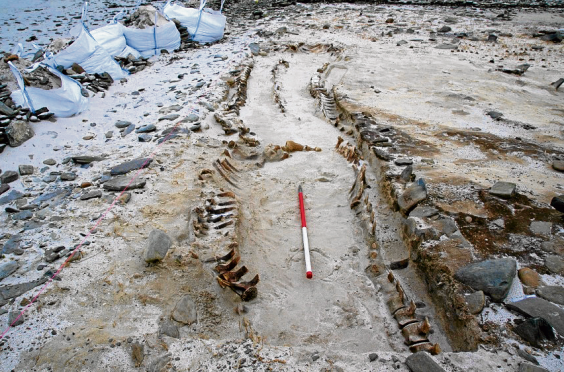Early neolithic houses and the skeletons of at least a dozen 19th century whales have been unearthed during an excavation on an Orkney island.
Archaeologists from the University of the Highlands and Islands Archaeology Institute are working on the site at Cata Sand on Sanday.
They are working with colleagues from the University of Central Lancashire, School of Conservation and Restoration of Cultural Heritage, Galicia, Spain and Cambridge University.
A spokesman for the UHI Archaeology Institute in Orkney said: “Perhaps the most amazing and unexpected discovery has been to find two large cut pits within the trench that contain the skeletons of a minimum number of 12 whales.
“Several people have recounted a tradition of whales being ca’d (driven) ashore at Cata Sands. We wondered if this tradition could account for the whale remains.”
The team has concluded that the structural remains are those of an early neolithic house (c.3400-3100BC) with associated occupation deposits, hearth and stone walls.
The house is unusual as it has been built on a deep layer of sand, which rests on rounded beach stones.
At least two construction phases have been recognised. The main house has a stone set hearth internal pits and boxes, and remains of the lower courses of a double-faced thick stone outer wall and small dividing stones, which partition the house into different living areas.
The institute spokesman said: “Although excavations at Pool uncovered some early neolithic structures in the 1980s, this is the first ‘classic’ early neolithic house to be discovered in Sanday. It is also contemporary with a stalled burial cairn situated just along the coast at Tresness, which is also being examined by the team.”
An extension and reconstruction of the earlier house is described by the team as “remarkable” and only seen at Ha’ Breck on the island of Wyre.
A range of finds associated with the Neolithic house including some fragments of pottery, Skaill knives, a grinding stone, flint working remains and animal bones have also been unearthed.
Preservation at the site is said to be excellent. The spokesman added: “This high degree of preservation will allow us to obtain a unique level of information regarding daily life within the early neolithic house.”










